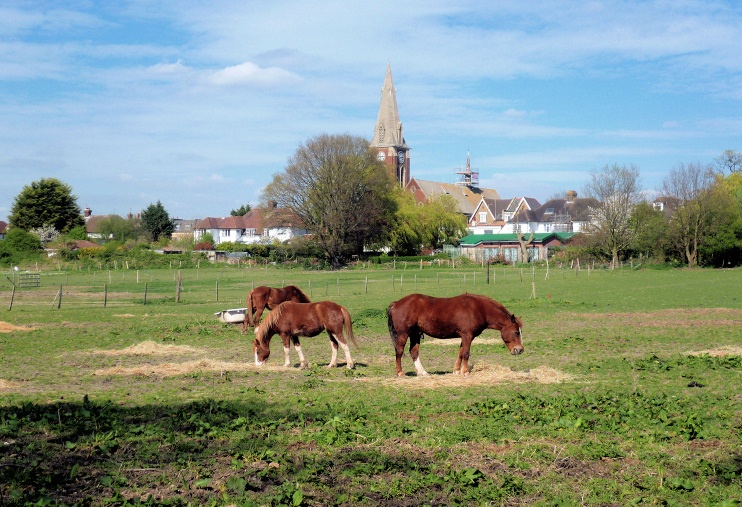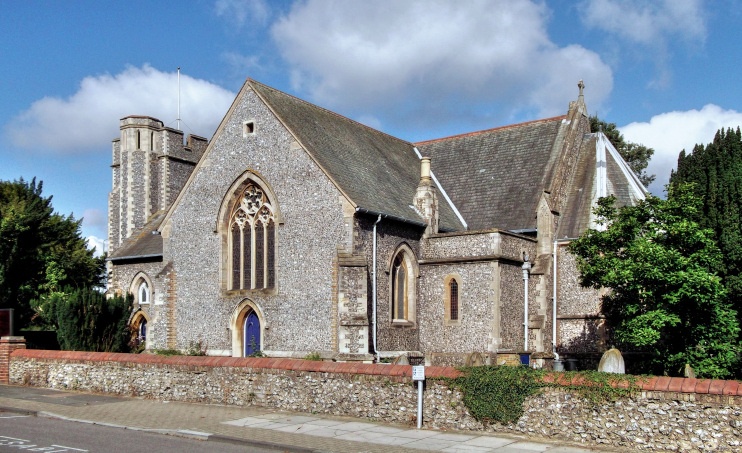Bromley Common
Bromley Common, Bromley
An elongated settlement and open space stretching southwards from Bromley towards Farnborough

A hamlet was in existence at Bromley Common by the 16th century. The diarist John Evelyn was robbed on the common in 1652, when his assailants jumped out from behind a large oak tree.
Enclosure of the common’s 300 acres began in 1764 and the Pye House, later the Crown public house (now a Toby Carvery), opened in the following year. The Rookery and Oakley House were the most substantial mansions built on the edge of the common in the 18th century. The latter became the home of Captain (and afterwards Admiral) Sir William Cornwallis.
Following the second stage of the common’s enclosure in 1821 villas were built on Hastings Road, with a row of cottages on what is now Oakley Road. The village had expanded significantly by the late 1830s and two of the cottages were converted into an infants’ school, while Holy Trinity church (shown in the photo below) was built in an economical style known as Commissioners’ Gothic. A purpose-built school opened beside the church in 1847.

To the north, the area around Chatterton Road was nicknamed ‘the building field’ in the 1870s, when it rapidly filled with terraced cottages, accompanied by shops and a large public house, now the Chatterton Arms. The 1880s saw the opening of a hospital for infectious diseases, the improvement of Holy Trinity and the building of St Luke’s church (visible in the photograph at the top of the page*), although its tower was not completed until 1910.
A bus garage opened in 1924 and another phase of expansion later in the decade necessitated more school building. To the west, the Norman family preserved the grounds of the Rookery until the army took over the house during the Second World War.
The Rookery burned down in 1946 while still under military occupation, after which green-belt legislation prevented development and ensured that much of this area has remained open space. Bromley technical college was built on the Rookery’s site in 1965 and this has since become the largest of the London South East Colleges’ campuses. The isolation hospital, later a geriatric care facility, was demolished and replaced by housing in the mid-1980s. Oakley House has become a Masonic hall that also serves as a conference, banqueting and wedding venue.
Across the road from the college, Asprey Homes and Barratt subsidiary Ward Homes laid out Trinity Village from 2010. The development replaced a company sports ground and was vainly opposed by Bromley council.
Cricket has been played on the common since at least 1735. From its formation in 1889 to the present day, Bromley Common cricket club has been based at the Grove, off Oakley Road.
Richmal Crompton, author of the Just William books, lived with her mother at 9 Cherry Orchard Road from 1917 to 1928. She wrote the first nine books in the series here and later moved to the Glebe, Oakley Road.
Postcode area: Bromley BR2
Population: 15,133 (Bromley Common and Keston ward, 2011 census)
Further reading: Amanda Peckham and Gill Humby, From the Workhouse to the Pye House: A History of Bromley Common, Local History Publications, 2000
and Mary Cadogan, Richmal Crompton and her Bromley Connections: The Woman Behind William, Lilburne Press, 2001
